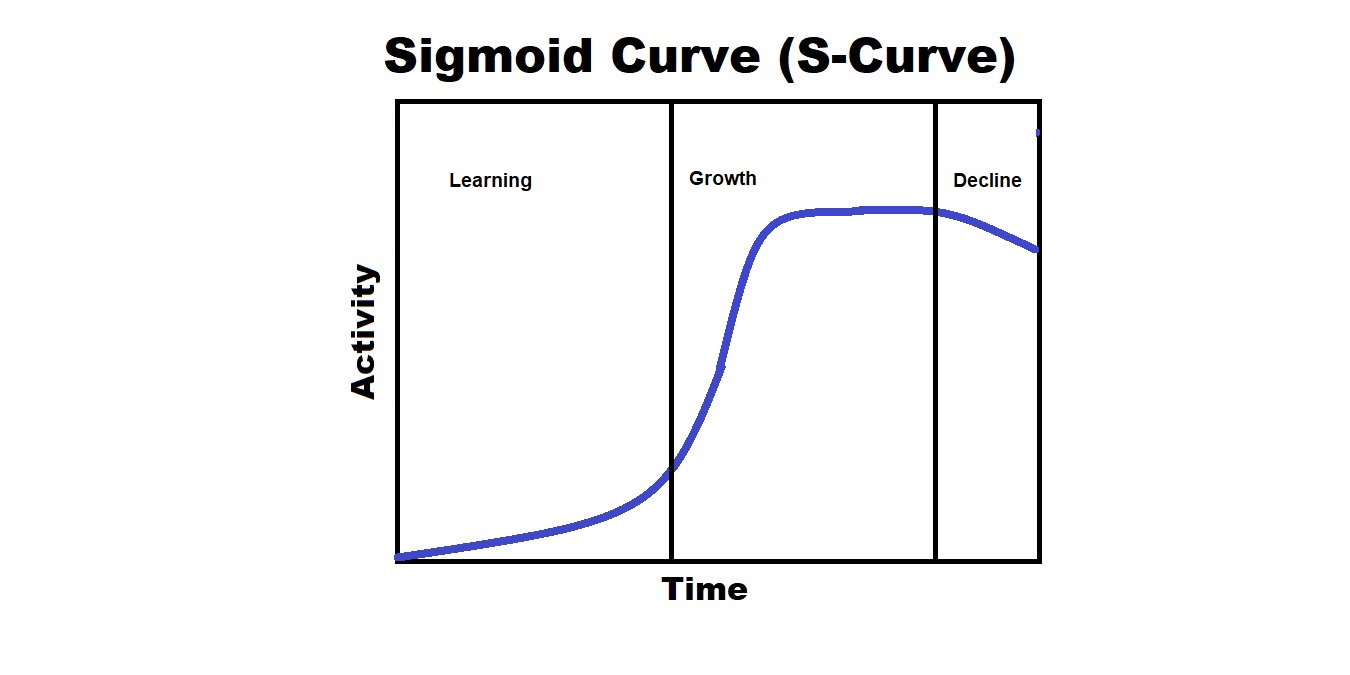Your life isn’t the same day to day. You have periods of highs, lows, and everything in between. The way you grow throughout your life can usually be modeled by a sigmoid curve. This is a widely-used mathematical way to explain growth cycles for living things, companies, careers, and more. Understanding how this curve affects your work life may help you increase your productivity and advance your career.
What Is the Sigmoid Curve?
If you’ve never heard of sigmoid cuves, it’s difficult to understand how they can affect your work life. The curve, which stems from the algebraic sigmoid function, can be applied to many areas of your life. The word “curve” derives from the S-shaped result from the function.
In life and work, the curve is on its side to signify the cycles of life. The American Psychological Association states that a sigmoid curve helps to describe many psychological processes, including learning.
In a more mathematical aspect, it’s a graphical representation of activity (Y axis) and time (X axis). These can also be referred to as learning and experience, respectively. Over time, your activity level rises, reaching a peak before descending into a decline – hence the S shape.
You don’t need to be a math expert to see how the curve applies to your life. The most important thing is recognizing the pattern of the curve to better understand how to make changes in your life at the optimal times.
Finding Your Place on the Curve
There are three main areas along the curve. The learning phase is the beginning and often grows slowly as you learn your way or adapt to something new. There may even be a few small dips here and there. It’s often considered one of the hardest phases but a critical one for success and growth.

The growth phase is a much more rapid rise that leads to your peak. You’ve already learned what you need to know. Now your confidence and abilities are growing. You’re able to proceed faster and accomplish more. It’s a great feeling and one you probably never want to end.
But then comes the third phase: the decline. Nothing lasts forever, which is something the sigmoid curve represents perfectly. Just as everything seems perfect, things start to fall apart. Those high energy levels you had during the growth phase start to fade. It becomes harder to stick with the same thing day in and day out.
You can also break the curve into five phases versus three. The learning phase is broken down into introduction and development. Growth becomes growth plus maturity, which represents the peak of the S curve. Of course, there’s still a decline.
The Learning Phase
To better understand the sigmoid curve, let’s dive into each phase a little more deeply. The learning phase is often excruciatingly slow. It could be the initial phase when you try to start a business and are just learning the basics. You’re not seeing much growth, if any. Sadly, this is often the period when many people give up on goals. Things are hard and success seems out of reach.

If you’re working toward a new career, this may be the literal learning phase. You’re trying to go back to school, take training courses, or learn on your own. It’s challenging, but you know all this hard work helps you to grow.
This is why this phase is sometimes broken down into introduction and development. You’re introducing yourself to something new and gradually developing. The more you develop, the faster you start to grow.
The Growth Phase
You’ll notice the sigmoid curve has a sharp and sudden rise after the gradual learning phase. This is the point where your learning or development is starting to pay off. If you’re an entrepreneur, this is the period where you’re out chasing clients and barely making ends meet. Your business is gaining traction, people are talking about it, and you’re starting to see real profits.
This phase can be somewhat gradual but usually happens much faster than the learning phase. Think of it as similar to a rollercoaster. It takes a while to get up that initial hill or rise, but when you do, it’s a fast-paced ride the rest of the way.

As mentioned before, growth also includes a sub-phase called maturity. This is where things start to reach a peak and level off. You’re not really growing any further, but nothing’s declining, either.
It’s easy to get complacent during this phase. Your hard work has paid off, so why bother doing anything else? The problem is, the sigmoid curve doesn’t stop at this phase.
The Decline Phase
What goes up must come down. An S turned on its side has a downward slope at the end. From a business point of view, this is the point where you either decide to adapt and make changes to prevent the decline, or you watch the competition pass you by.
RocketSource refers to the point where maturity is reaching its inevitable end as a strategic inflection point. This is the point where a change has to be made. Waiting too long means starting the long learning phase all over again as you decline to the point you were when you started or even further.

RocketSource points out examples of companies that didn’t pay close enough attention to the point where they could have prevented a decline. Blackberry, Kodak, and Yahoo are great examples. They were all at the top of their game but didn’t change with the times.
Polaroid is another great example of a company that suffered a decline – multiple times. But the company continues to ride the S-shaped curve, continuing to find what works.
You don’t have to endure this phase. By applying the sigmoid curve to work and your personal life, you can recognize your strategic inflection point, making the necessary changes before you start the decline. In this case, your curve starts to rise after a minor dip following the growth phase.
Applying the Sigmoid Curve to Work
All of this is great, but how does it apply to work or individual growth? Charles Handy describes this perfectly. He states that to be more effective and grow in life, your sigmoid curves should overlap. Instead of waiting to drop off the peak into the decline phase, use the growth phase to begin another curve. This creates a constant cycle of learning and growth.
Based on the phases of the curve, nothing stays the same forever. Eventually, there will be a decline. Human nature is to wait for that decline. After all, if you’re happy where you are, why not just enjoy it instead of jumping into something new?

While that does make sense, remember that as you enter the decline phase, your energy levels decline too – you’re not as productive. It’s harder to find the desire to change in any meaningful way. This means your decline could last a while, leaving you feeling less confident and making it more difficult to learn.
Even small changes to your day and routine can help re-energize you to start a new curve. The idea is that old processes won’t work forever. Trying new ways of doing things boosts your productivity and growth.
Identifying When to Start New
This is tricky because only you will really know when it’s time to start a new curve. However, as a general rule, it’s a good idea to start thinking about positive changes that will spur new growth just as you’re reaching the beginning of your growth phase. As things are just starting to get better and you’re feeling stronger from the learning phase, it’s time to start planning your next curve.

As you pick up momentum into your growth phase, your energy levels rise too. This gives you what you need to feel excited about new changes. For instance, when you achieve a major life goal, it’s probably a sign for you to start changing your daily processes, learn something new, add a new challenging responsibility, or try a new productivity hack.
The key is to challenge yourself in some way to grow and become better at what you do and what you want to do. For example, if you need a career change, try to start the process before you become burned out from your old career. Of course, it’s never too late to start a new sigmoid curve, but it’s easier if you can start before the peak in your current one.
